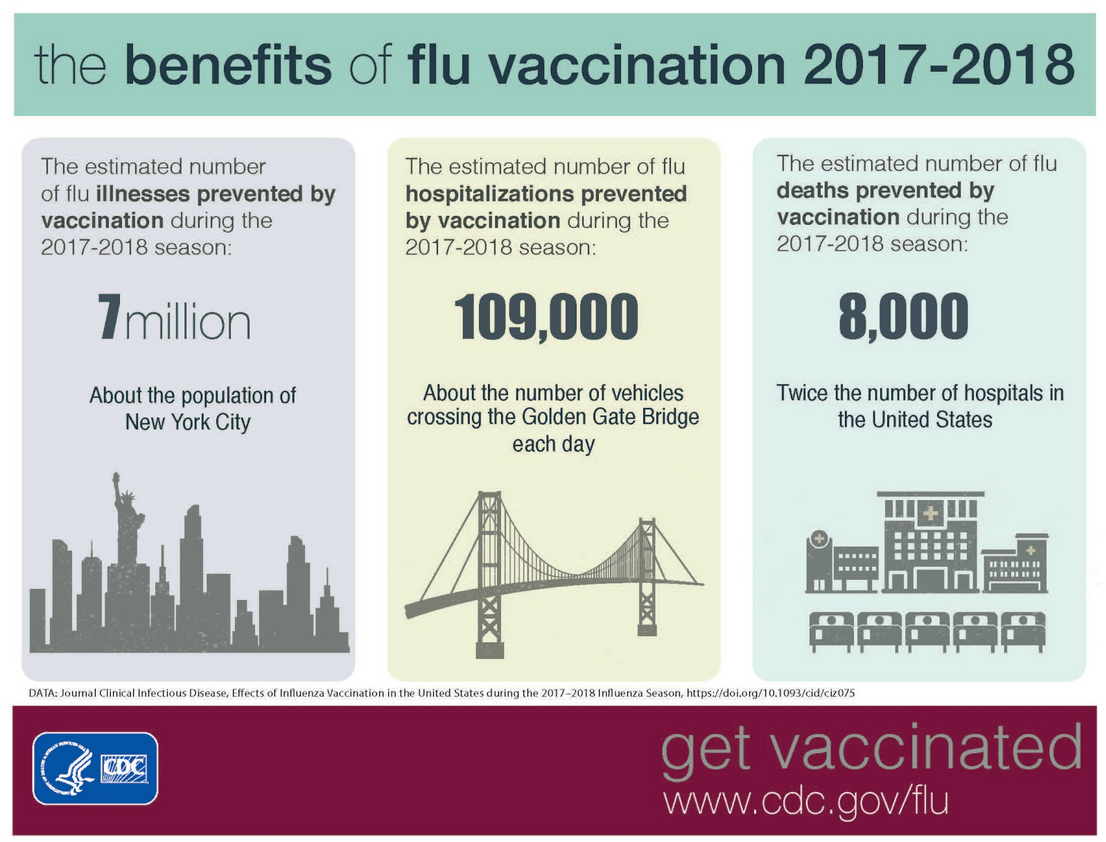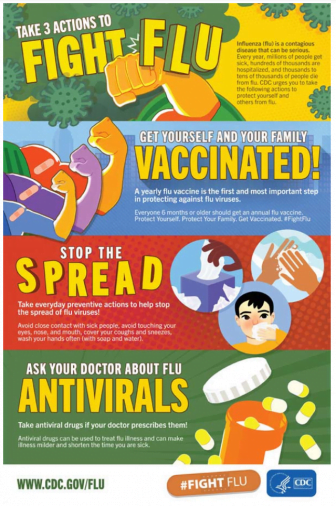By Alex LaTrenta, Greenwich Academy class of 2020
Sixth in a series of articles about the prevention, recognition, and treatment of public health threats in Greenwich.
A startling 8 percent of Americans will contract the flu this season. In the winter of 2017 to 2018 the Center for Disease Control (CDC) estimates that 45 million people in the US had symptomatic flu which led to 21 million medical visits, 810,000 hospitalizations, and 61,000 deaths.
Although most people with flu will just miss several days of work or school, some otherwise healthy people may die or may infect people at high risk for flu complications such as children under five, pregnant women, adults over 65, and those with chronic medical conditions like diabetes, heart disease, or asthma.
The scale of influenza as a public health menace indicates that individuals must know how to protect themselves from this annual threat for the collective health of our community.
Although the severity and timing of influenza outbreaks vary and evolve each year, the flu season generally begins in October and continues through April or May. Health professionals have posed a plethora of hypotheses to explain why flu strikes in the winter including more time spent indoors or a suppressed human immune response.
However, a study by Mount Sinai School of Medicine as reported in the New York Times proposes that the answer to this mystery may stem from the structure of the virus itself. Influenza viruses are more stable in the crisp winter air and stay longer on surfaces in a dry, indoor atmosphere. As people transmit the virus in tiny airborne droplets, humid spring air causes the droplets to fall to the ground thus halting the flu epidemic until the next season.
Influenza is caused by a variety of viruses that infect the nose, throat, and in severe cases, the lungs. As a myriad of Influenza A and B strains are responsible for the seasonal epidemics, the CDC and the World Health Organization (WHO) collect worldwide data to predict which strains will dominate annually and thus direct the creation of an appropriate vaccine.
The primary way to prevent influenza infection is vaccination for everyone above 6 months old. Unfortunately, only 30 to 40 percent of the US population seek vaccination each season.
Despite popular belief, the flu vaccine cannot give you the flu as it does not contain live organisms. Instead it exposes one’s immune system to dead influenza proteins which stimulate the development of antibodies. This process can cause fatigue for a day and requires two weeks before the vaccine confers immunity against these viral strains.
A vaccine cannot uniformly prevent influenza; a person’s individual health and the match between circulating flu viruses and the predicted strains influence the efficacy. However, vaccination can significantly reduce the potential for contracting the flu if exposed and the risk of serious complications if infected.
Dr. Ralph Cipriani, an Infectious Disease specialist and Internist with Greenwich Concierge Care, said, “Even if you think you are not going to get the flu or you’ve never had the flu, do yourself a favor and take precautions. Get a flu shot! It’s never too late to protect other members of our community, especially your family. Not everyone can fight off the flu as well as you can.”
Many local pharmacies provide flu shots through insurance carriers. While Connecticut law states that pharmacies cannot give flu vaccines to children under the age of 18 even with parent permission, young adults between the ages of 18 and 21 can obtain verbal permission from a parent over the phone. New York pharmacies can provide flu shots to a child of any age with parental permission.
Check with your local pharmacy and pediatrician or use the health map vaccine finder recommended by the CDC to find doctor’s offices for flu vaccinations.

In addition to receiving a flu shotCipriani notes “it’s important to use frequent handwashing and alcohol gel because flu can be transmitted through surfaces as well as from coughing or sneezing.”
Cipriani advises to “cover your mouth with your arm. Don’t get those infected respiratory droplets all over the place. And if you are sick, stay home from work or school.” While infected people are most contagious within the first three to four days, they can transmit the virus one day before the onset of symptoms and for up to seven days afterwards.
Learning how to recognize flu symptoms may prevent the spread of influenza and may allow people to receive potentially life-saving medication. Cipriani notes that “generally the patients with flu present quite ill-appearing—headaches, cough, sore throat, body aches, and pains—and they will almost always have a fever over 101 … they feel really bad, and they look really bad.”
If patients seek medical attention within 48 to 72 hours they are eligible to receive antiviral medications. Dr. Steven Schiz of the Children’s Medical Group frequently offers antivirals to his flu patients because they “don’t cure the flu—it’s not like an antibiotic for strep throat—but they reduce the duration of symptoms by two to three days. So if the typical flu lasts 6 days maybe you are feeling better sooner. “
Drugs such as Tamiflu and Xoflusa can also prevent serious complications like pneumonia, sinus infections, and ear infections. Schiz recommends antivirals for exposed family members because they can take a lower dose of the drug to potentially avert infection.
 While Schiz often diagnoses flu clinically by recognizing the symptoms, he can perform tests for influenza in his office which can confirm the diagnosis. A rapid flu test from a swab of the nose or throat can accurately detect flu in 80 percent of cases and takes only 20 minutes.
While Schiz often diagnoses flu clinically by recognizing the symptoms, he can perform tests for influenza in his office which can confirm the diagnosis. A rapid flu test from a swab of the nose or throat can accurately detect flu in 80 percent of cases and takes only 20 minutes.
Cipriani notes that if you do not get vaccinated you “are doing yourself a disservice especially if you are older. If you get the flu, not everyone gets better. . . especially the elderly or very young children whose immune systems are not as capable at combating the flu. Not only are you potentially harming yourself but loved ones and the community at large.”
For the benefit of our town, Greenwich citizens must try their best to minimize the severity of the flu season and consider what can be done to protect ourselves and our loved ones from the flu.
See also:
Protecting Man’s Best Friend: Recognizing and Preventing Illness in the Family Dog
The Emerging Epidemic of Vaping-Associated Lung Injury: Is Our Youth’s Health Going Up in Smoke?
Protecting our Collective Brain Power From Stroke: Every Second Counts
CT Dept of Health Announces Third Death from Eastern Equine Encephalitis
Protecting You and Loved Ones from Lyme Disease: The Snake in the Greenwich Grass